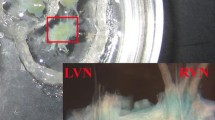Summary
-
1.
Single and multi-fiber responses were recorded from the nerves of the angular acceleration receptors (crista) ofOctopus vulgaris under the following conditions: (i) animal stationary, (ii) during angular acceleration from different resting positions relative to gravity, and (iii) during rotation at constant angular velocity. Rotations were around earth-vertical and earth-horizontal axes.
-
2.
In all experiments the discharge frequency of the receptor neurons varied as a function of the orientation of the crista with respect to gravity (Figs. 1, 2).
-
3.
The preparation excluded the possibility of interaction between the crista being observed and other equilibrium receptors; also, the perilymph-endolymph mechanics were not changed. Therefore, it is hypothesized that the angular acceleration receptors ofOctopus are responsive to linear acceleration (gravity) in addition to their well established sensitivity to angular acceleration.
Similar content being viewed by others
References
Barber, V. C.: The fine structure of the statocyst ofOctopus vulgaris. Z. Zellforsch.70, 91–107 (1966)
Barber, V. C.: The structure of mollusc statocysts, with particular reference to cephalopods. Symp. Zool. Soc. London23, 37–62 (1968)
Benson, A. J., Bodin, M. A.: Effect of orientation to the gravitational vertical on nystagmus following rotation about a horizontal axis. Acta oto-laryng. (Stockh.)61, 517–526 (1966)
Benson, A. J., Guedry, F. E., Melvill Jones, G.: Response of semicircular canal dependent units in vestibular nuclei to rotation of a linear acceleration vector without angular acceleration. J. Physiol. (Lond.)210, 475–494 (1970)
Budelmann, B.-U.: Die Arbeitsweise der Statolithenorgane vonOctopus vulgaris. Z. vergl. Physiol.70, 278–312 (1970)
Budelmann, B.-U., Barber, V. C., West, S.: Scanning electron microscopical studies of the arrangements and numbers of hair cells in the statocysts ofOctopus vulgaris, Sepia officinalis andLoligo vulgaris. Brain Res.56, 25–41 (1973)
Budelmann, B.-U., Wolff, H. G.: Electrophysiological study of the gravity receptors ofOctopus vulgaris. (In preparation 1973)
Dijkgraaf, S.: The statocyst ofOctopus vulgaris as a rotation receptor. Pubbl. Staz. Zool. Napoli32, 64–87 (1961)
Goldberg, J. M., Fernandez, C.: Physiology of peripheral neurons innervating semicircular canals of the squirrel monkey. I. Resting discharge and response to constant angular accelerations. J. Neurophysiol.34, 635–660 (1971)
Guedry, F. E.: Psychophysiological studies of vestibular function. In: Neff, W. D. (ed.), Contributions to sensory physiology, vol. 1, p. 63–135. New York-London: Academic Press 1965a
Guedry, F. E.: Orientation of the rotation-axis to gravity: Its influence on nystagmus and the sensation of rotation. Acta oto-laryng. (Stockh.)60, 30–48 (1965b)
Janeke, J. B.: On nystagmus and otoliths. Thesis. Amsterdam: Cloeck en Moedigh 1968
Jongkees, L. B. W.: Physiologie und Pathophysiologie des Vestibularorganes. Arch. klin. exp. Ohr.- Nas.- u. Kehlk.-Heilk.194, 1–110 (1969)
Lowenstein, O.: Electrophysiological experiments on the isolated surviving labyrinth of the elasmobranch fish to analyse the responses to linear accelerations. In: Stahle, J. (ed.), Vestibular function on earth and in space (Proc. Barany Society, Uppsala 1968), p. 35–41. Oxford-New York: Pergamon Press 1970
Maturana, H. M., Sperling, S.: Unidirectional response to angular acceleration recorded from the middle cristal nerve in the statocyst ofOctopus vulgaris. Nature (Lond.)197, 815–816 (1963)
Udo de Haes, H. A., Schöne, H.: Interaction between statolith organs and semicircular canals on apparent vertical and nystagmus. Acta oto-laryng. (Stockh.)69, 25–31 (1970)
Vinnikov, Y. A., Gasenko, O. G., Bronstein, A. A., Tsirulis, T. P., Ivanov, V. P., Pyatkina, G. A.: Structural, cytochemical and functional organization of statocysts of cephalopoda. Symposium on Neurobiology of Invertebrates, p. 29–48. Budapest: Akadémiai Kiadó 1967
Wolff, H. G., Budelmann, B.-U.: Properties of angular acceleration receptors inOctopus vulgaris. (In preparation 1973a)
Wolff, H. G., Budelmann, B.-U.: Electrical responses of theOctopus statocyst receptors to vibration. (In preparation 1973b)
Young, J. Z.: The statocysts ofOctopus vulgaris. Proc. roy. Soc. B152, 3–29 (1960)
Author information
Authors and Affiliations
Additional information
The authors thank Dr. D. B. Parker, Oxford, Ohio, for his constructive help in improving the English text, and the Max-Planck-Gesellschaft for the use of their research table at the Zoological Station in Naples. The work was supported in part by grant Wo 160/2 of the Deutsche Forschungsgemeinschaft (DFG).
Rights and permissions
About this article
Cite this article
Budelmann, BU., Wolff, H.G. Gravity response from angular acceleration receptors inOctopus vulgaris . J. Comp. Physiol. 85, 283–290 (1973). https://doi.org/10.1007/BF00694234
Received:
Issue Date:
DOI: https://doi.org/10.1007/BF00694234




